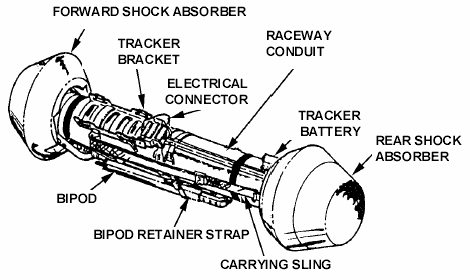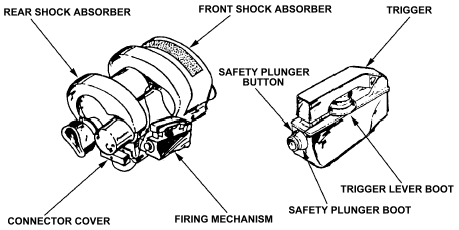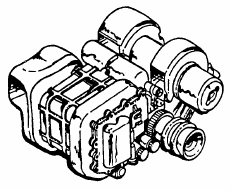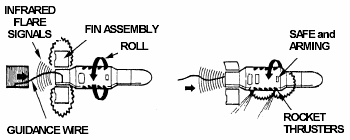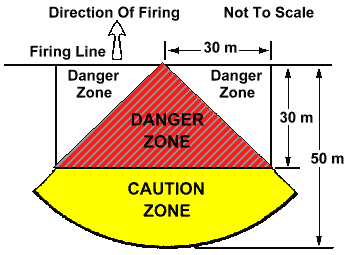| TECHNICAL DATA |
|---|
| Complete System |
|---|
| Country of Origin | USA |
|---|
| Date Of Introduction | 1975 |
|---|
| Weight | 32.1 lb (14.57 kg) with daysight. 46.9 lb (21.29 kg) with nightsight |
|---|
| Length | 45.4 in (1,154 mm) |
|---|
| Diameter | 11.5 in (292 mm) |
|---|
| Caliber | 5 in (127 mm) |
|---|
| Minimum Range | 71 yd (65 m) |
|---|
| Maximum Range | 1,094 yd (1,000 m) with 11.2 seconds time of flight |
|---|
| Daysight - Infrared Tracker, Guided Missile, SU-36/P |
|---|
| Weight | 6.8 lb (3.10 kg) |
|---|
| Length | 7.72 in (196 mm) |
|---|
| Field of view | 6° |
|---|
| Magnification | 6 power |
|---|
| Nightsight - Night Vision Sight, Tracker, Infrared, AN/TAS-5 |
|---|
| Weight | 21.65 lb (9.82 kg) |
|---|
| Length | 14.5 in (368 mm) |
|---|
| Field of view | 3.4° by 6.8° |
|---|
| Magnification | 4 power |
|---|
| M175 Mount |
|---|
| Weight | 82.8 lb (37.6 kg) |
|---|
DESCRIPTION
The M47 Dragon is a surface-attack, wire-guided, man-portable, shoulder-fired, medium antitank weapon system.
It can defeat armored vehicles, fortified bunkers, concrete gun emplacements, and other hardened targets.
The individual soldier or a two-man team can operate this weapon.
The Dragon's primary role is to destroy enemy armored vehicles.
When there is no armored vehicle, the Dragons can be employed in a secondary role of providing fire support against point targets such as bunkers and crew-served weapons positions.
Combat and combat support units normally use the Dragon in a self-defense role during rear operations.
The Dragon weapon system consists of a daysight, a nightsight, and a round of ammunition.
Mechanized infantry gunners can use the Dragon with the M175 guided missile launcher mount.
This mount provides a stable platform on either the M113 APC or on the M3 or M122 machine gun tripod.
The Dragon can engage targets in daylight (with the daysight) and in limited visibility conditions, such as smoke, fog, or darkness (with the nightsight).
Deployed to the Persian Gulf in 1990 for Operations Desert Shield and Desert Storm. A few Dragons were fired during
combat, but the missile was considered to be "a weapon of last resort" due to difficulty when aiming,
exposure of the gunner to enemy fire, and the missile's inability to penetrate the latest add-on and reactive armors.
Replaced the M67 90mm recoilless rifle in U.S. service. Replaced by the Javelin missile in U.S. service.
LAUNCHER
The Dragon's ammunition is an expendable component consisting of both the missile and the launcher itself.
The missile is installed in the launcher at the factory and is shipped ready to fire.
The launcher serves as a storage and carrying case for the missile before it is launched.
The round consists of a smooth bore fiberglass launch tube with missile stored inside. The launch
tube has a tracker battery that provides power to the tracker and fires the missile. The tracker bracket provides the
electrical connections necessary for missile, trigger, and tracker operation. The bipod is attached to the forward end
of the launch tube and supports the launcher during operations.
The launcher consists of:
- A smooth-bored fiberglass tube.
- A breech and gas pressure generator assembly.
- A wiring harness.
- A sling.
- Forward and rear shock absorbers.
- A sight battery, which provides power to operate the sight and fire the missile.
- A sight support bracket, which houses the Dragon's electrical connectors.
- A bipod, which supports the weapon system during dismounted firing.
AMMUNITION
Three rounds are available for use with the Dragon: the M222 and MK1, MOD 0 tactical rounds (HEAT warheads), and M223 practice round
(inert warhead). All rounds use the same basic airframe, aerodynamic control system, command-link wire, and missile electronics design.
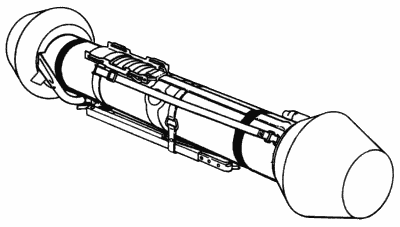

Dragon ammunition data.
| |
M222 HEAT round |
MK 1, MOD 0 HEAT round |
M223 inert practice round |
|---|
| Length |
29.29 in (744 mm) |
33.32 in (846 mm) |
33.32 in (846 mm) |
|---|
| Weight |
25.29 lb (11.47 kg) |
27.2 lb (12.34 kg) |
10.4 lb (4.70 kg) |
|---|
| Arming Range | 71 yd (65 m) | N/A |
|---|
Maximum Effective Ranges
Beyond these ranges there is less than a 50% chance of hitting the target. |
|---|
| Stationary Target | 1,094 yd (1,000 m) |
|---|
| Moving Target | 109 yd (100 m) |
|---|
SU-36/P Daysight
The daysight is an electro-optical sight that determines the position of the missile relative to the gunner's line of sight (LOS).
Note that the sight unit is sometimes called a "tracker."
The daysight attaches to and removes quickly from the round. The daysight's aluminum housing assembly contains the lens, infrared receiver assembly, and control signal comparator. The firing mechanism, located on the right side of the daysight's housing, consists of a trigger safety plunger and trigger lever bar.
- The daysight's lens is a 6-power telescope.
- It magnifies the image across a 6° field of view (FOV) to help the gunner locate, identify, and track targets.
- A fitted and molded rubber eye guard protects the gunner's eyes and allows him to adjust rapidly to the sight.
- The infrared receiver consists of an objective lens assembly, graded filter, infrared detector, and nutator mirror.
- It detects any deviations or excursions of the missile from the gunner's LOS.
AN/TAS-5 Nightsight
At dusk, or anytime the light level drops below what is needed to use the daysight, Dragon gunners switch to the nightsight.
Note that the sight unit is sometimes called a "tracker."
It attaches to the round the same as the daysight.
The firing mechanism, control system, and guidance system are the same as those on the daysight.
- The passive, 4-power AN/TAS-5 nightsight has a 3.4° by 6.8° field of view.
- The nightsight is larger and heavier than the daysight.
- The nightsight converts heat emissions (infrared energy) from a target area into electrical signals, then to visible light.
This enables the nightsight to display a real-time scene.
- Objects warmer than the ambient (surrounding) temperature appear in shades of red; cooler objects appear black.
- Like the daysight, the nightsight monitors the missile and sends commands to keep it on the gunner's line of sight.
- The AN/TAS-5 uses rechargeable batteries and employs small gas cylinders or bottles for cooling the detector electronics.
These batteries and cooling bottles have a life of 2 hours.
M175 Mounting Assembly
The M175 mount provides a stable launch platform to fire the missile from the M113-series APC and the M3 or M122 machine gun tripod.
The tracker mount provides the electrical connection between the round and tracker.
A remote firing mechanism is located on the right rear side of the cradle for easy access by the gunner.
The azimuth and elevation damper assemblies reduce vibration and provide a firm but steady tracking action.
FIRING POSITIONS
The Dragon can be fired from any one of the three basic firing positions: sitting, standing supported, or kneeling.
When the M175 mount is installed on the M3 or M122 machine gun tripods, the gunner can use a modified sitting or standing supported position.
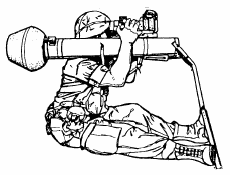
Sitting position
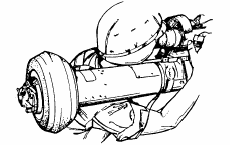
Position of round on shoulder
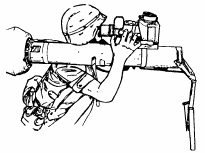
Standing supported position
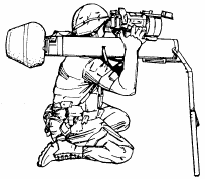
Kneeling position
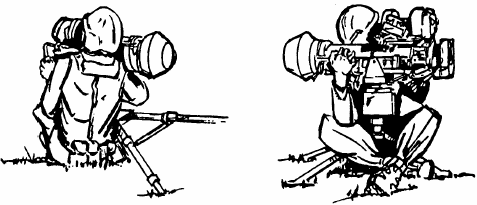
M3 position (left) and M122 tripod position (right)
FIRING
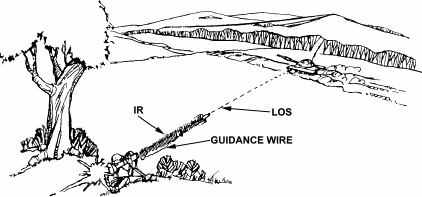
- To fire the Dragon, the antiarmor specialist looks through the sight and puts the crosshairs on the target.
He keeps the crosshairs on the target and fires.
-
As the missile leaves the launch tube, the infrared flares begin to operate, and the command-link wire is dispensed from the missile.
The missile fins fold out and lock into place. The safety and arming device sequence is completed after the missile has traveled
about 71 yards (65 m).
- The sight's electronic controls compare the missile's position with the gunner's line of sight (LOS).
It sends electronic position information to the missile through the command-link wire.
- Based on information received from the sight, the missile generates commands to correct its position.
The missile may store the commands until it rolls to the proper position for its rocket motors to fire, or it may fire the rocket motors immediately to correct the missile's position relative to the gunner's LOS.
- The missile's rocket motors fire to accelerate it or to correct its position.
The gunner keeps the cross hairs on the selected aiming point until impact.
- To fire a second round, the gunner releases the spring clip at the rear left side of the sight support assembly, slides the sight forward, and lifts it clear of the support.
The gunner expends or destroys and discards the round in accordance with unit SOP.
The gunner either prepares another round or he secures the sight and any extra rounds and prepares to displace on order.
BACK BLAST
The Dragon back blast area extends 164 feet (50 m) to the rear and 30 meters to the flanks of the launcher.
This area is divided into two zones: a danger zone and a caution zone.
- The danger zone extends 98 feet (30 m) to the rear of the launcher in a 90° cone.
Within this area, the blast, flame, and flying debris could cause deaths or serious casualties, so personnel must avoid this zone.
- The caution zone extends an additional 66 feet (20 m) to the rear and 98 feet (30 m) to the flanks of the danger zone.
Personnel should try to avoid this area as well. To protect their eyes from flying debris, they must face away from the rear of the Dragon.
To protect their ears from the blast and overpressure, they must wear earplugs.
WEAPON CAPABILITIES
The Dragon missile has a minimum arming distance of 213 feet (65 m), which severely limits its use in urban areas. Few areas in the
inner city permit fires much beyond the minimum arming distance. Ground-level long-range fires down streets or rail lines and across
parks or plazas are possible.
Dragon penetration against structural materials.
| Packed Earth | 8 ft (2.4 m) |
|---|
| Reinforced Concrete | 4 ft (1.2 m) |
|---|
| Steel Plate | 13 in (330 mm) |
|---|
Dragon Photos - Click on image sample to see full size image.

U.S. Army Photo
576x720, 43K, JPEG

U.S. Army Photo
720x576, 34K, JPEG



